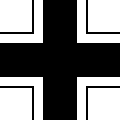Panzer VII Löwe
The German Panzerkampfwagen VII Löwe (Lion) was a WW II design by Krupp to give the Germans a superheavy tank. Originally it was to come in two variants; one with a frontal armor of 100 mm (Leichte Loewe, weighing in at 76 tons), and one with 120 mm frontal armor (Schwere Loewe, weighing in at 90 tons). The light version was ot have the turret mounted at the rear, while the heavy one would have the turret mounted on the centre, while both would mount 105 mm L/70 high velocity gun and a coaxial machine gun. They were both to have a crew of five. They would both use a 1000 hp engine, giving the heavy version an estimated speed of 23 km/h and the light one 27 km/h.
When showed the designs, Hitler ordered the light version to be dropped. The heavy version was to be redesigned so as to field a 150 mm gun, have 140 mm frontal armor, and the speed was to be increased to 30 km/h.
The project never left the drawing board. There was several redesigns, but ultimately it was dropped in late 1942 in favor of the Maus. However many of the ideas concieved for the Schwere Loewe was used in the Königstiger.
We will never know how this tank would have fared in combat. It is quite likely that it would have had some of the same problems as the Königstiger, that was expensive to produce, and had difficulty moving over small bridges due to its size. It is generally agreed that the biggest problem for the Königstiger was that it's engine could only generate about 650 hp. With 1000 hp the Löwe would have had a slightly higher power-to-weight ratio, but it has been speculated that this still would not have been adequate. Should it be doubted however that the armor of the Löwe would have been sufficient to protect it from late models of soviet antitank guns such as the 122mm, it ought to be remembered that the armor of 100-140 mm was heavily sloped and thus would have offered a surprising amount of protection (about 220-300 mm RHA-equivalent), though, due to inadequate tank design, less than would have been possible for a tank that heavy.

